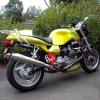Leaderboard
Popular Content
Showing content with the highest reputation on 11/12/2019 in all areas
-
As an tangential anecdote; I play with classic cars, and have a good friend in the restoration business. Primarily he's concerned with Chrysler products of the 60s and 70s. One of his regular customers asked if he'd return to service a pristine MG Midget that had been parked for a decade. He asked if I'd help, because I have some experience with English cars and bikes. After the typical fuel system service and fluid changes, it came to life quite easily, all under the criticism of my friend. "Go-cart" "Tiny motor" "Why would anyone bother?". Needless to say, he drove it around for a full week, taking it everywhere including a car show. When I pressed him to admit it was a good time, of course he did; What we isolated as the true source of the fun was that you could drive the car about as hard as you cared to, without risking limb and license. Banging up through third gear with your foot on the floor and the top down is different but almost as good as blowing the tires up on a '70 440 'Cuda, and a lot less likely to attract points to your license. Point being, I spent most of my life searching for performance improvements in everything I ever owned, only to discover that a great deal of it would have been better spent riding what was there instead of working on it. A 'Guzzi is what it is. Trying to make it something else may be fun and satisfying, but if the actual research and development isn't a good time in itself, it isn't worth the loss of actual riding time. I ask myself, "How often am I actually at WOT?" Rarely. I do, however, take the time to fine tune what's there and I separate projects now so I can pursue what I feel like at the moment. <shrug> Defining the ends to our means is important.4 points
-
Honda sells a ton of Groms. Thing is, you can ride them WOT all day, every day - and no one but you knows this. Meanwhile you are ginning like an idiot inside your helmet. A form of the "Big, dirty fun" of which P.J. O'Rourke wrote. .2 points
-
Re; high compression pistons. The historic battle within hemispherical combustion chambers is always between compression and detonation. Firstly, in the U.S., the DOT mandates than anything sold for highway use operate on 87 octane fuel without destroying itself. So, if you're willing to use premium always (who doesn't, anyway?) there is a little room for increases. Here's where things get messy. Firstly, tuning an engine to take advantage in the difference between 87 and 93 octane is something only an expert with a dynomometer, or a very experienced butt and ears, can do meaningfully. Secondly, there really isn't that much difference anyway. If you're capable of such, you're also capable of tuning your intake and exhaust, fuel and timing as is to achieve 80% of the difference with such a mild compression increase. Lastly, altitude and camshaft have huge effect on cylinder pressures, particularly at the medium RPM range where detonation is most prevalent. Hemispherical combustion chambers are the most efficient design from the perspective of (2-valve) valve/flow size and efficiency. But they are the worst for detonation. The most effective counter to detonation is turbulence during compression, which achieves 2 specific things; improves homogenization of the mixture which removes 'dead' or 'late' spots in the burn; and speeds completion of burn which removes unburned mixture from corners which overpressure and detonate. Without enormous and expensive changes, there's little we can do with stock Guzzi castings to improve squish, which creates turbulence. What I did on my LM1000 though, was to carefully measure quench-the actual distance between the piston and head- to be certain it was optimized. The term 'quench' is used, because it's known that the fuel/air mix *cannot* ignite within a narrow margin of distance. That distance is somewhere between .050" and .025". It's typically recognized that the worst contained distance for detonation with gasoline is about .080". You can measure your quench with a piece of soft solder through the spark plug hole, to discover to some degree where you are and if taking a little off your cylinders may have some benefit. IIRC I took about .015" off the LM, which raised the compression by about half a point. That said, it has a Web 86b camshaft, which although has far more lift than the stock cam, also creates much more cylinder pressure in the low RPMs. The combination requires that I retard the timing a couple degrees from stock to kill any apparent detonation. Tuning is ongoing, currently. I always read these back before posting, and I'm never sure they convey sufficiently the information. :/2 points
-
After a trip to the White Mtns. last month I decided to lower my V11 LeMans foot pegs for a bit more comfort. My mechanic and I found a way to lower the stock foot pegs using existing mounting holes. It lowers them about an inch. I can gain another inch if I switch to Buell pegs. But for now, these are significantly more comfortable. Attached are before and after pics of both sides. The left side is a simple swap. The right side needs a different bolt. (Still lovin' the bike Tim! It's my go to GT bike.) Mike1 point
-
Yup. Also the oil that came out of it, (And other bikes with these things fitted.) always stinks so heavily of fuel it's hardly oil any more. When 8V's eat their tappets one of the first signs is blackening of the oil. It doesn't stink of fuel though, a bit more 'Burnt' than you would expect but it doesn't smell fuelly though. Heavily contaminated oil also 'Feels' different if you rub it between your fingers. Believe me, I've seen it many times now. It's not just a random sample of one! Pete1 point
-
If the fuelling has been overly rich for a long period then oil dilution would be an issue which wouldn't be doing the already dodgy lifters any favours. I guess this was Petes point? Ciao1 point
-
The injection, good as it is, is not nearly as refined as that on our cars. Cars require no "cold start" lever, have more engine condition sensors, much more powerful computers, coil-on-plug and particularly detonation/knock sensors. Thus, the highest performing cars can run on 87, or even the gasoline substitute called Pemex in Mexico. Not saying they'll be happy. but they'll run. Hemispherical combustion chambers trace back an awful long way - to a time before flame propagation was thought of as influencing the production of power. Aircraft engine designers had to deal with pistons melting from the immense dome absorbing so much of the combustion heat. Few had yet thought of tilting the valves toward each other and flattening the chamber. As usual, racing forced the issue and Cosworth et al showed the gains to be had in multi valves and compact combustion chambers. Have not really examined the 4-valve Guzzi heads, but they are no doubt much more efficient than the two-valvers. The valve train being the wrench in the gears of the 4-valve Guzzis. 4 valves done right, plus liquid cooling of cylinder and head would show real gains, but at the cost of complexity and increased maintenance - but maintenance is part of Guzzi life, is it not? Sadly, Piaggio has fallen for the "Italian Harley" niche and sport bikes and power production have taken it in the shorts. Even Harley has stealth liquid cooling as they are forced to compete. Ducati consistently shows what a 4-valve V-twin can do with the application of cubic Euros to the formula. Guzzi has not had that freedom since the V8. Oh, but these old hemis do alright for what they are. I have ridden 500s and 650s as my largest bikes, so 1064cc seems like a revelation. Trade up from a smaller bike and the V11 seems much more satisfying. Still the carrot dangles and 100 hp up from 91 seems so close that one can reach it.1 point
-
Oh , they are righteous , with a few problems . I had one on a 70 Mustang 351c 4spd . I had a 600 cfm double pumper with a chrome dual line I installed on it . I was George Thorogood in that car !1 point
-
For most of us non-competitive, street guys, "hot-rodding" may be an exaggeration. "De-restricting" or "opening up" what is stuffed up probably nets the greatest practical increase for the money. A freer intake and exhaust will net a noticeable difference when one enters the second half of the rev counter. And re-flashing that which may not have been all that well flashed in the first place.1 point
-
Great write up, docc. My V11, out of all the bikes I've owned, is the most sensitive to a tune up. It really is night and day.1 point








